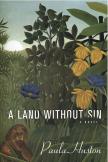A Brother Lost
Prospero, stepping out of his role as the reinstated Duke of Milano in William Shakespeare’s great play “The Tempest,” delivers an epilogue directly to the audience. It is in fact Shakespeare ruminating about the artist, the response of the public, the meaning of the project itself, “…which was to please.” And what pleases, in the case of “The Tempest,” is the complexity of language, structure and story that illustrate and engage human experience.
Complexity lifts art beyond entertainment and “pleases” in the sense that it provides an encounter, a challenge, a spiritual awakening. It places demands on one to be a witness, to take a stand, to consider historical alternatives. It presumes a disposition to be engaged emotionally in the human turmoil. An art that engages and pleases has the multiple effect of an emotional, intellectual and spiritual experience.
Paula Huston’s novel A Land Without Sin weaves together a complexity of themes: archeology, political revolution, the demise of the Mayan civilization, the meaning of suffering and the tension between vengeance and mercy. While the themes serve as a structure upon which to build an absorbing story, the intricacies of Mayan culture, the tensions of church and politics, and the unique stance of the Zapatista movement in Chiapas, all receive a summary and sometimes-stereotypical treatment.
The novel begins with Eva, a 34-year-old photojournalist from Chicago, and her employer, Dr. Jan Bource, a middle-aged Dutch archeologist who studies the ancient Mayan civilization in Tikal, Guatemala. Eva accepts a temporary job as photographer for the archeologist, but conceals her real mission, which is to find her missing brother, a priest, in the jungles of Chiapas. Jan is no less secretive about his reasons for photographing a certain glyph that appears repeatedly in the burial vaults of ancient Mayan sites.
Complementing these characters are Jan’s wife, Anne and Eva’s brother, Stefan. Anne is an archeologist, whose career has ended with the onset of a chronic illness. She lives and is cared for in a modest family home in Palenque, Mexico. Something of a mystic, she maintains buoyancy in the face of illness and death, mainly by her strong Quaker faith. She and Eva are opposite souls from their first meeting, but Anne’s personality gradually opens Eva to a deeper reality beyond material data. Later in the story Eva will express the transcendent reality in terms of a great photograph: “a really great picture is how much of that comes through, even though you can’t see it with the naked eye.”
Stefan, the missing brother, makes his presence felt in the course of the novel through letters sent to his sister by way of a mutual friend from a California monastery. Eva reads and rereads these letters, which gradually disclose the motives for Stefan’s rebellion as an adolescent and his subsequent path to becoming a priest and volunteering for pastoral work in a part of the world that is on the verge of revolution. The last letters also shed light on his sudden disappearance from San Cristóbal de las Casas in Chiapas.
An initial antipathy between Jan and Eva diminishes once the archeological trio of Jan, his teenage son and Eva move from Tikal through Palenque and on to San Cristóbal. The archeologist reveals his cowardice, after witnessing his mother’s prolonged death, as the reason for his ambivalence about his wife’s condition. He discloses his theory that the mysterious glyph is a symbol of an underground movement in opposition to blood sacrifice and elaborate rituals during the classic period of Mayan history.
While Eva remains silent about her brother during her conversations with Jan, she recognizes in Stefan’s letters something akin to the hypothetical Mayan resistance movement. It becomes clear that Stefan’s rejection of blood sacrifice as atonement, revenge or mob catharsis has marked him deeply. In his last letter, left for Eva to find in his abandoned parish room, Stefan reveals the catalyst for his early rebellion and later conversion: the tragic involvement of their immigrant grandfather in a Croatian concentration camp during the Nazi era. That fact, and the studies and commitments that followed in Stefan’s personal journey, are the reasons for his decision to retreat to the jungle as a pacifist presence in the guerilla camps. Another reason for his disappearance is his determination to rescue an indigenous friend from resorting to vengeance for the death of his father at the hands of a rich Mexican landowner.
With the Zapatista uprising in San Cristóbal, Eva seizes her chance to disappear from her colleagues and begin her trek to find her brother in the Lacandon jungle. Her guide, the only one to be found for the task, is a would-be native and social loner who claims to know the jungle well. Rebel forces quickly detain the incongruous duo, and from there, with some improbable turns, the story reaches a foreseeable outcome.
Creating a work of art involves hard work. What lifts the effort beyond the ordinary is its capacity to move and engage an audience in a lasting manner. When Shakespeare puts himself at the mercy of his public in Prospero’s epilogue, he asks his audience to measure their involvement. Paula Huston’s novel absorbs the reader with a well-told story. Less engaging are the characters, their development and the depth of their communication. Ultimately, A Land Without Sin entertains more than it pleases, and leaves the reader wishing for less material data and more transcendent reality.
This article also appeared in print, under the headline “A Brother Lost,” in the May 26-June 2, 2014, issue.








